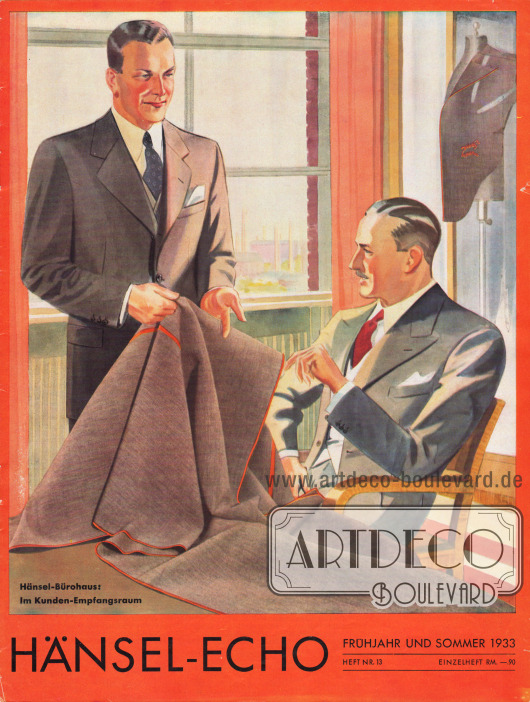|
P. 1 |
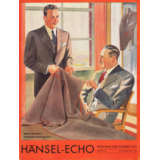
|
Front page of the spring/summer issue of the company magazine Hänsel-Echo No. 13 from 1933, entitled "Hänsel office building: In the customer reception area".
Drawing: Harald Schwerdtfeger (1888-1956).
|
|
P. 2 |
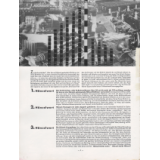
|
Hänsel-Werke's own advertising for the processed Hänsel horsehair yarns.
"1st Hansel value. Only high-quality, fine horsehair over 50 cm to more than 110 cm in length is used for the Hansel horsehair that goes on sale.
2nd Hansel value. Hansel hair yarn is always double combed.
3rd Hansel value. The Hänsel shrinkage.
Hansel offers more - Hansel remains Hansel!"
The upper section shows four different photographs from the Hänsel production area. Horsehair tails in ascending and descending lengths are lined up in the foreground next to a one-meter measure.
photographs: Hansel works.
|
|
P. 3 |

|
"Three unique Hansel values that you won't find anywhere else, that you can't see on the outside, but that make Hansel 'Hansel' in the first place."
The top two photos show the different horsehair qualities and their expert appraisal. Below that, four photos of the production facilities from inside the Hänsel factories are shown. The finished Hänsel product is spread out in the centre.
Photos: Hansel Factories.
|
|
P. 4 |

|
Elegant men's suits 1933 for slim and stronger built men.
The line is characterized by broad shoulders, a light but distinct waist and a narrow but loosely cut hip. According to "Hansel-Echo", the closing button should be exactly at the waist. "The spring single-breasted suit, usually with three buttons, has a falling shape, while the summer single-breasted suit with two buttons has a rising shape [lapel].
Drawing: Harald Schwerdtfeger (1888-1956).
|
|
P. 5 |
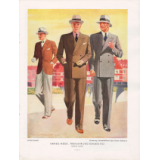
|
Men's suits for spring and summer 1933.
The line is characterized by broad shoulders, a light but distinct waist and a narrow but loosely cut hip. According to "Hansel-Echo", the closing button should be exactly at the waist. Shown here are a single-breasted summer suit and two double-breasted suits with two or three buttons.
The Hänsel-Echo remarks briefly on the double-breasted summer jacket: "The transition of the double-breasted jacket and the button position have become narrower.
Drawing: Harald Schwerdtfeger (1888-1956).
|
|
P. 6 |
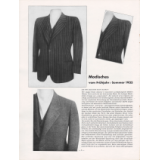
|
Article:
Henschke, Bruno, Fashionable things from Spring/Summer 1933.
The article, which summarizes the fashion line for suits, coats for men and sportswear, is supplemented by three photographic close-ups of two jackets.
photographs: Hansel Works.
|
|
P. 7 |

|
Article:
Henschke, Bruno, Fashionable things from Spring/Summer 1933.
In the upper right-hand corner of the page, the fashionable measurements for jackets and men's coats for Spring/Summer 1933 are also given. In 1933, the average man had a height of 1.72 m.
The article is also supplemented by two photographs showing the inner life of a jacket and a finished Paletot coat.
|
|
P. 8 |
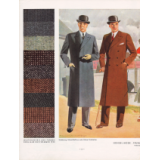
|
Two Paletot coats for men. On the left are also nine patterns and fabric colours for spring and summer 1933.
The "Hansel Echo" to fashionable coats "The single-row Paletot with concealed placket always has a high profile. His waist may only be hinted at. The lapels of the double-rowed paletot are to be worked in such a way that the upper button, which is usually worn openly, can still be closed comfortably. Coats like Ulster have back seams and back slits.
Drawing: Harald Schwerdtfeger (1888-1956).
|
|
P. 9 |
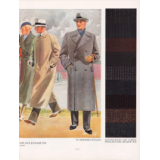
|
A double breasted ladies coat, a Paletot coat with concealed button facing and a double breasted Ulster coat for men. On the right are also nine patterns and fabric colours for spring and summer 1933.
The "Hansel Echo" to fashionable coats "The single-breasted Paletot coat with concealed placket always has a raised button facing. His waist may only be hinted at. [...] Ulsters are always double-breasted and close with three pairs of buttons. Coats like Ulster have back seams and back slits.
Drawing: Harald Schwerdtfeger (1888-1956).
|
|
P. 10 |
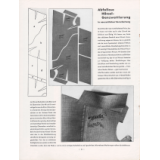
|
Article:
O. V., Garbageless Hänsel full wadding in modern processing.
The article is supplemented by the drawing in the upper left-hand corner and two photographs that show the processing of the Hansel pieces and cut pieces in an exemplary manner.
photographs: Hansel works.
|



